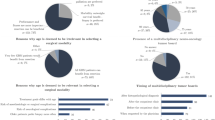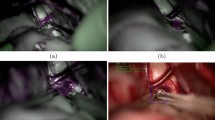Abstract
Purpose
Reliable intraoperative delineation of tumor from healthy brain tissue is essentially based on the neurosurgeon’s visual aspect and tactile impression of the considered tissue, which is—due to inherent low brain consistency contrast—a challenging task. Development of an intelligent artificial intraoperative tactile perception will be a relevant task to improve the safety during surgery, especially when—as for neuroendoscopy—tactile perception will be damped or—as for surgical robotic applications—will not be a priori existent. Here, we present the enhancements and the evaluation of a tactile sensor based on the use of a piezoelectric tactile sensor.
Methods
A robotic-driven piezoelectric bimorph sensor was excited using multisine to obtain the frequency response function of the contact between the sensor and fresh ex vivo porcine tissue probes. Based on load-depth, relaxation and creep response tests, viscoelastic parameters E1 and E2 for the elastic moduli and η for the viscosity coefficient have been obtained allowing tissue classification. Data analysis was performed by a multivariate cluster algorithm.
Results
Cluster algorithm assigned five clusters for the assignment of white matter, basal ganglia and thalamus probes. Basal ganglia and white matter have been assigned to a common cluster, revealing a less discriminatory power for these tissue types, whereas thalamus was exclusively delineated; gray matter could even be separated in subclusters.
Conclusions
Bimorph-based, multisine-excited tactile sensors reveal a high sensitivity in ex vivo tissue-type differentiation. Although, the sensor principle has to be further evaluated, these data are promising.










Similar content being viewed by others
References
Kuhnt D, Bauer MHA, Nimsky C (2012) Brain shift compensation and neurosurgical image fusion using intraoperative MRI: current status and future challenges. Crit Rev Biomed Eng 40(3):175–185
van Leyen K, Klotzsch C, Harrer JU (2011) Brain tumor imaging with transcranial sonography: state of the art and review of the literature. Ultraschall in der Medizin 32(6):572–581
Finke M, Kantelhardt S, Schlaefer A, Bruder R, Lankenau E, Giese A, Schweikard A (2012) Automatic scanning of large tissue areas in neurosurgery using optical coherence tomography. Int J Med Robot Comput Assist Surg MRCAS 8(3):327–336
Kirsch M, Schackert G, Salzer R, Krafft C (2010) Raman spectroscopic imaging for in vivo detection of cerebral brain metastases. Anal Bioanal Chem 398(4):1707–1713
Steiner G, Sobottka SB, Koch E, Schackert G, Kirsch M (2011) Intraoperative imaging of cortical cerebral perfusion by time-resolved thermography and multivariate data analysis. J Biomed Opt 16(1):16001
Colditz MJ, van Leyen K, Jeffree RL (2012) Aminolevulinic acid (ALA)-protoporphyrin IX fluorescence guided tumour resection. Part 2: theoretical, biochemical and practical aspects. J Clin Neurosci 19(12):1611–1616
Kern TA (2009) Engineering haptic devices: a beginner’s guide for engineers. Springer, Dordrecht
Lee MH, Nicholls HR (1999) Review article tactile sensing for mechatronics—a state of the art survey. Mechatronics 9(1):1–31
Eltaib MEH, Hewit JR (2003) Tactile sensing technology for minimal access surgery—a review. Mechatronics 13(10):1163–1177
Rahim RA, Waduth MFA, Jaafar HI, Ayob NMN, Leow PL (2012) Current trend of tactile sensor in advanced applications. Sens Transducers 143(8):32–43
Tiwana MI, Redmond SJ, Lovell NH (2012) A review of tactile sensing technologies with applications in biomedical engineering. Sens Actuators A 179:17–31
Lucarotti C, Oddo CM, Vitiello N, Carrozza MC (2013) Synthetic and bio-artificial tactile sensing: a review. Sensors 13(2):1435–1466
Saccomandi P, Schena E, Oddo C, Zollo L, Silvestri S, Guglielmelli E (2014) Microfabricated tactile sensors for biomedical applications: a review. Biosensors 4(4):422–448
Bonomo C, Brunetto P, Fortuna L, Giannone P, Graziani S, Strazzeri S (2008) A tactile sensor for biomedical applications based on IPMCs. IEEE Sens J 8(8):1486–1493
Brunetto P, Fortuna L, Giannone P, Graziani S, Pagano F (2010) A resonant vibrating tactile probe for biomedical applications based on IPMC. IEEE Trans Instrum Meas 59(5):1453–1462
Hemsel T, Stroop R, Uribe DO, Wallaschek J (2007) Resonant vibrating sensors for tactile tissue differentiation. J Sound Vib 308(3–5):441–446
Tanaka Y, Yu Q, Doumoto K, Sano A, Hayashi Y, Fujii M, Kajita Y, Mizuno M, Wakabayashi T, Fujimoto H (2010) Development of a real-time tactile sensing system for brain tumor diagnosis. Int J Comput Assist Radiol Surg 5(4):359–367
Johannsmann D, Langhoff A, Bode B, Mpoukouvalas K, Heimann A, Kempski O, Charalampaki P (2013) Towards in vivo differentiation of brain tumor versus normal tissue by means of torsional resonators. Sens Actuators A 190:25–31
Uribe DO, Schoukens J, Stroop R (2018) Improved tactile resonance sensor for robotic assisted surgery. Mech Syst Signal Process 99:600–610
Uribe DO, Stroop R, Wallaschek J (2009) Piezoelectric self-sensing system for tactile intraoperative brain tumor delineation in neurosurgery. In: Conference proceedings: annual international conference of the IEEE engineering in medicine and biology society, vol 2009. IEEE Engineering in Medicine and Biology Society, pp 737–740
Uribe DO, Zhu H, Wallaschek J (2010) Automated measurement system for mechanical characterization of soft tissues and phantoms. In: 2010 International conference on electronic devices, systems and applications (ICEDSA), pp 227–231
Madsen EL, Hobson MA, Shi H, Varghese T, Frank GR (2005) Tissue-mimicking agar/gelatin materials for use in heterogeneous elastography phantoms. Phys Med Biol 50(23):5597–5618
Brunetto P, Fortuna L, Giannone P, Graziani S, Strazzeri S (2010) Static and dynamic characterization of the temperature and humidity influence on IPMC actuators. IEEE Trans Instrum Meas 59(4):893–908
Kollar I (1993) On frequency-domain identification of linear systems. IEEE Trans Instrum Meas 42(1):2–6
Cheng L, Xia X, Scriven LE, Gerberich WW (2005) Spherical-tip indentation of viscoelastic material. Mech Mater 37(1):213–226
Seber GAF (2004) Multivariate observations. Wiley, New York
Green MA, Bilston LE, Sinkus R (2008) In vivo brain viscoelastic properties measured by magnetic resonance elastography. NMR Biomed 21(7):755–764
Jalkanen V, Andersson BM, Bergh A, Ljungberg B, Lindahl OA (2006) Resonance sensor measurements of stiffness variations in prostate tissue in vitro—a weighted tissue proportion model. Physiol Meas 27(12):1373–1386
Sasaki T, Haruta M, Omata S (2014) Ct elastography: a pilot study via a new endoscopic tactile sensor. Open J Biophys. https://doi.org/10.4236/ojbiphy.2014.41004
Omata S, Terunuma Y (1992) New tactile sensor like the human hand and its applications. Sens Actuators A. https://doi.org/10.1016/0924-4247(92)87002-X
Acknowledgements
This work was founded by the European Research Council (ERC) Advanced ERC Grant No. 320378–SNLSID (Johan Schoukens). David Oliva Uribe would like to thank the support and motivation of Beatriz Vizcaino. In addition, the authors thank to the personnel of the Slaughter House Anderlecht for kindly providing the ex vivo samples.
Author information
Authors and Affiliations
Corresponding author
Ethics declarations
Conflict of interest
The authors declare that they have no conflict of interest.
Research involving human participants and/or animals
This article does not contain any studies with human participants performed by any of the authors.
Ethical approval
For this type of study, formal consent is not required. This article does not contain patient data.
Rights and permissions
About this article
Cite this article
Stroop, R., Nakamura, M., Schoukens, J. et al. Tactile sensor-based real-time clustering for tissue differentiation. Int J CARS 14, 129–137 (2019). https://doi.org/10.1007/s11548-018-1869-5
Received:
Accepted:
Published:
Issue Date:
DOI: https://doi.org/10.1007/s11548-018-1869-5




